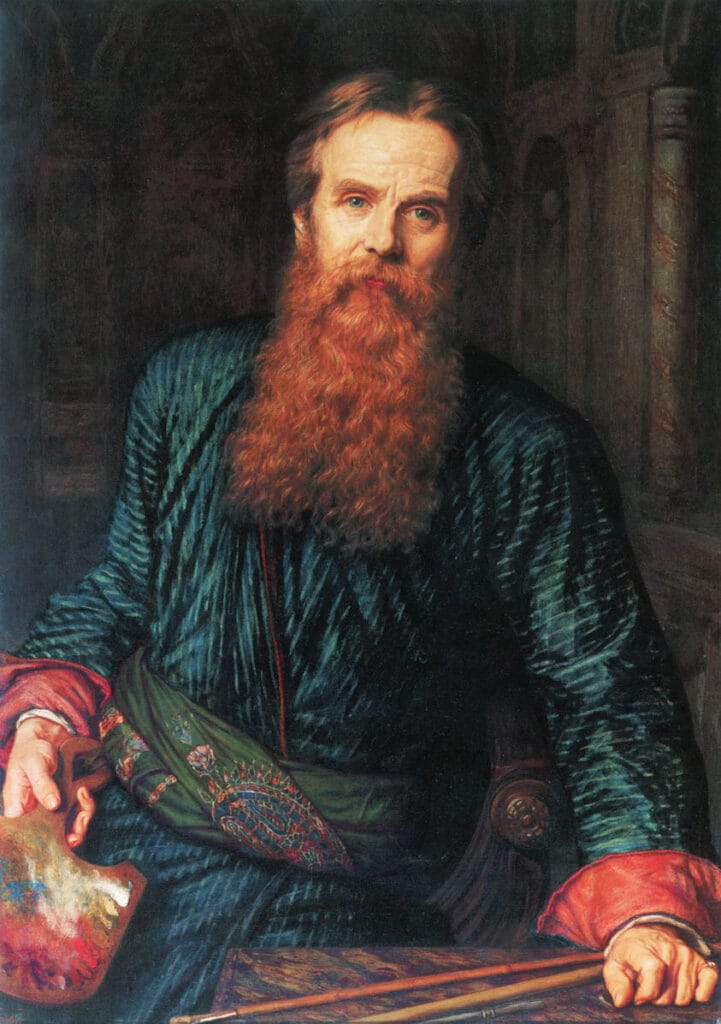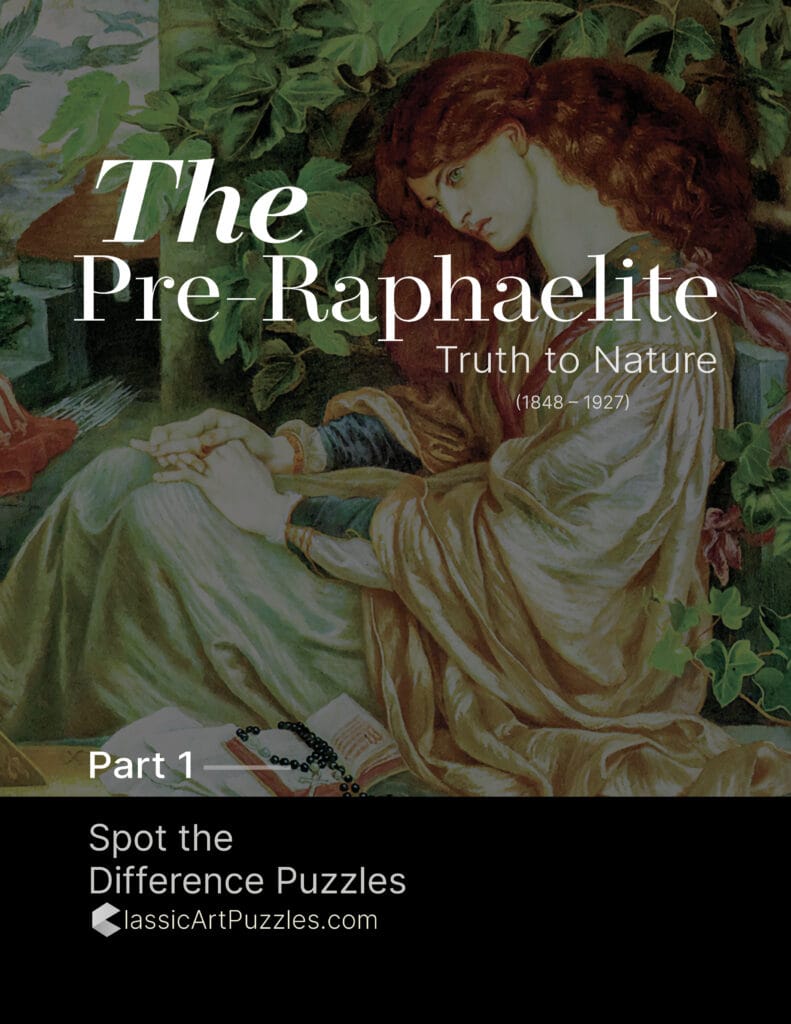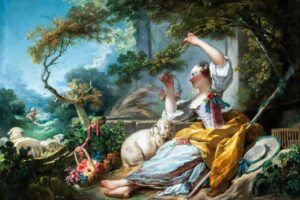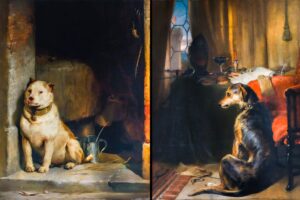Table of Contents
Overview
The Hireling Shepherd (1851) by William Holman Hunt is a vivid Pre-Raphaelite allegory that fuses pastoral detail with spiritual warning. The painting shows a shepherd neglecting his flock as he flirts with a country girl in the meadow. Behind them, the sheep stray dangerously toward crops, while the shepherd offers an apple as temptation.
Hunt (1827–1910), one of the three founders of the Pre-Raphaelite Brotherhood, was devoted to “truth to nature” and moral storytelling. In this work, he uses dazzling color, meticulous realism, and layered symbolism to create more than a rustic love scene — it is a parable of negligence, temptation, and misplaced devotion.
Exhibited in 1852 at the Royal Academy, the painting was praised for its brilliance of detail but criticized for its unconventional allegory. Today, it is recognized as a cornerstone of Pre-Raphaelite art, combining everyday realism with biblical resonance and moral depth.

About the Artist
William Holman Hunt (1827–1910) was an English painter and a founding member of the Pre-Raphaelite Brotherhood. Known for his painstaking attention to natural detail, jewel-like color, and moral symbolism, Hunt sought to restore spiritual intensity to art. His works often drew on biblical subjects, literature, and rural life, blending realism with allegory. He influenced generations of Victorian painters with his commitment to nature and narrative truth.
The Story Behind the Painting
Biblical and Moral Symbolism
The title refers to Christ’s warning in the Gospel of John about the “hireling shepherd,” who neglects the flock and allows them to stray. Hunt uses this parable to symbolize spiritual negligence: the shepherd is distracted by sensual temptation while his sheep wander into danger. The apple in his hand alludes to the Fall of Man, underscoring the theme of temptation.
Pre-Raphaelite Brotherhood Ideals
Painted in 1851, this work exemplifies the Brotherhood’s rejection of academic conventions in favor of close observation and symbolic storytelling. Hunt painted the scene in Surrey with painstaking fidelity to nature, recording each blade of grass, each sheep, and every apple with extraordinary precision.
Victorian Context
To Victorian audiences, the allegory was clear: a warning against carelessness in faith, love, and duty. The tension between sensual attraction and spiritual responsibility made the painting provocative and morally urgent for its time.
Composition and Subjects
The Shepherd and Maiden
At the center, the shepherd kneels beside a young woman, leaning too close as he tempts her with an apple. She looks away, uneasy yet not fully rejecting him. Their intimacy is contrasted by the moral failure it represents — a devotion to passion over responsibility.
The Straying Flock
Behind them, the sheep wander into a field of corn, trampling the crop. This detail symbolizes the danger of neglected duty, aligning the literal shepherd with spiritual leaders who allow their flocks to go astray.
The Lamb and Apples
In the maiden’s lap lies a lamb, symbol of innocence, surrounded by fallen apples — further reminders of temptation, fragility, and the cost of neglect.
Landscape and Detail
Every inch of the canvas is filled with Pre-Raphaelite naturalism: wildflowers, meadow grasses, glistening water, and dappled light. Hunt’s devotion to accuracy transforms the pastoral scene into a dazzling yet unsettling allegory.
Art Style and Techniques
Truth to Nature
Hunt painted outdoors directly from nature, a radical practice in 1851. The result is a tapestry-like surface where every leaf, flower, and ripple of light is recorded with intensity.
Symbolism in Realism
Unlike traditional allegories, Hunt embeds symbolism within naturalistic detail. The apple, lamb, cornfield, and sheep are all ordinary rural elements, yet together they convey profound spiritual and moral lessons.
Pre-Raphaelite Brilliance
The colors are radiant — deep reds, lush greens, golden light — recalling medieval stained glass. Hunt’s style here is both decorative and deeply narrative, embodying the Brotherhood’s mission to restore truth, intensity, and spirituality to modern painting.
Legacy and Reflection
Early Masterpiece
The Hireling Shepherd secured Hunt’s reputation as a leader of the Pre-Raphaelite movement. It combined narrative clarity, biblical resonance, and dazzling execution in a way few paintings of the period could match.
Lasting Meaning
Today, the painting remains a striking example of how the Pre-Raphaelites transformed Victorian art. Its message endures: beauty without responsibility leads to loss, and neglect of duty has consequences both spiritual and human.
Featured in Our Collection
The Hireling Shepherd is featured in our Pre-Raphaelite Spot-the-Difference Puzzle Flipbook. This interactive collection celebrates masterpieces by Hunt, Millais, and Rossetti, offering a fresh way to experience their symbolic detail. By exploring hidden differences within Hunt’s intricate pasture and flock, you sharpen focus, memory, and appreciation for the layered storytelling of Pre-Raphaelite art.
Temptation in the Meadow
The shepherd tempts with an apple, the maiden turns aside, and the sheep stray into ruin. In The Hireling Shepherd, Hunt transforms a rustic scene into a moral vision, where every blade of grass and every gesture warns of temptation, neglect, and the fragile balance of innocence and duty.




